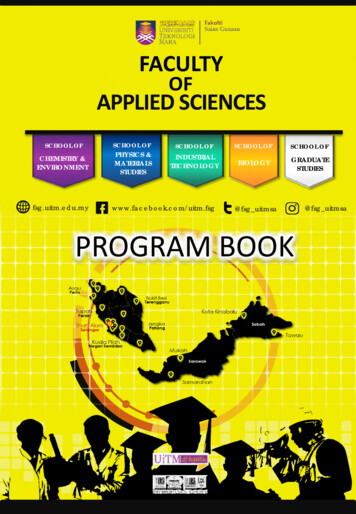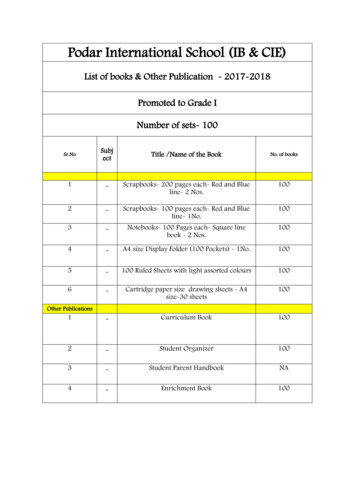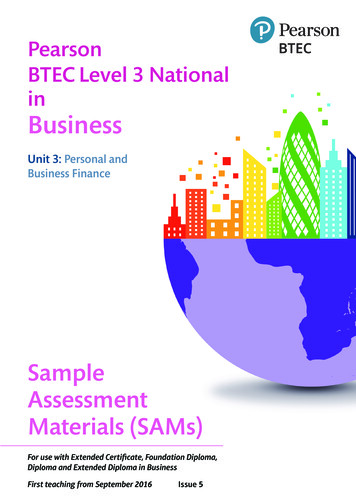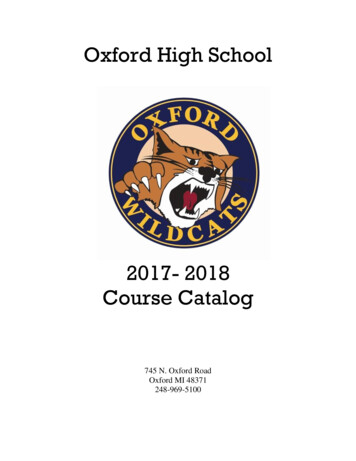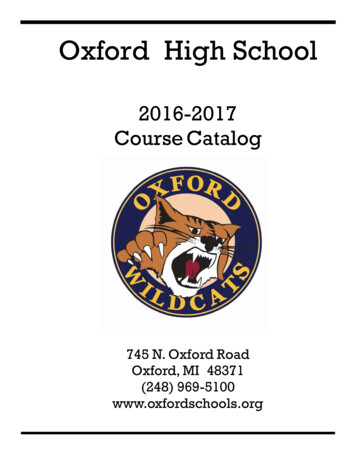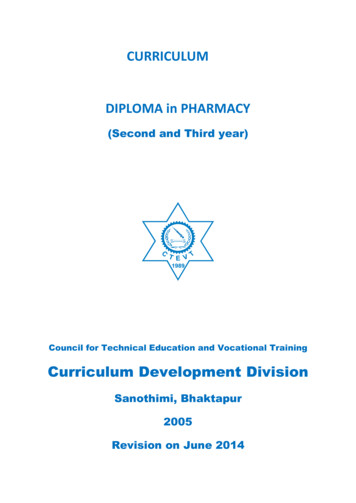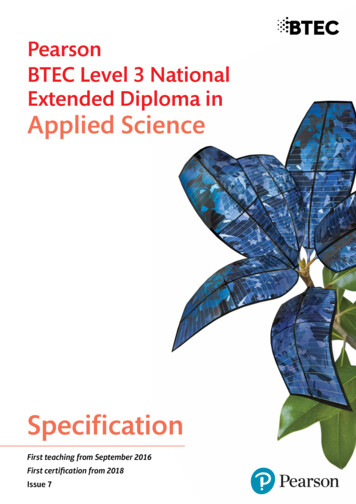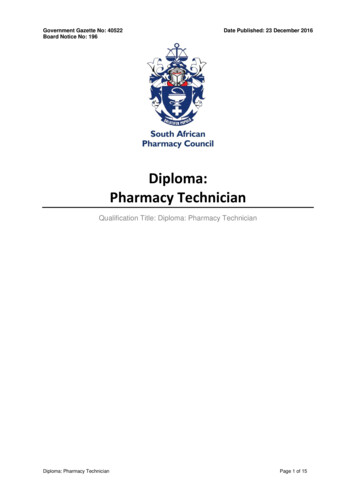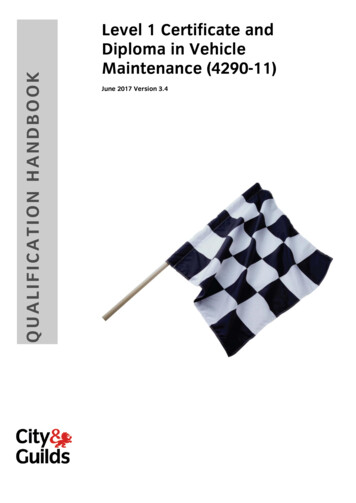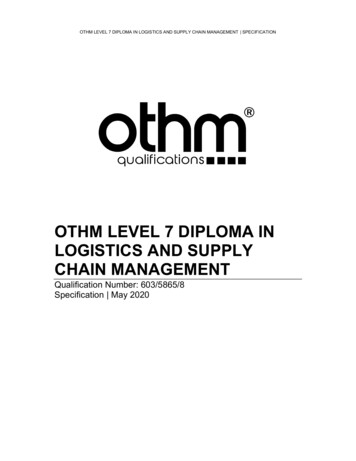
Transcription
OTHM LEVEL 7 DIPLOMA IN LOGISTICS AND SUPPLY CHAIN MANAGEMENT SPECIFICATIONOTHM LEVEL 7 DIPLOMA INLOGISTICS AND SUPPLYCHAIN MANAGEMENTQualification Number: 603/5865/8Specification May 2020
OTHM LEVEL 7 DIPLOMA IN LOGISTICS AND SUPPLY CHAIN MANAGEMENT SPECIFICATIONTABLE OF CONTENTSQualification Objectives. 3Regulatory Information . 3Equivalences . 3Qualification Structure . 4Definitions . 4Entry Requirements . 4Progressions . 5Delivery of OTHM qualifications . 5Assessment and Verification . 5Opportunities for learners to pass . 5Recognition of Prior Learning and Achievement. 6Equality and Diversity. 6Unit Specifications . 7Logistics Management. 8Supply Chain Planning, Modelling and Analytics . 11Procurement and Supply Management. 14Supply Chain and Operations Strategy . 17Sustainable Operations Management . 20Business Research Methods . 23Important note . 26SPECIFICATION MAY 2020WWW.OTHM.ORG.UKPAGE 2 OF 26
OTHM LEVEL 7 DIPLOMA IN LOGISTICS AND SUPPLY CHAIN MANAGEMENT SPECIFICATIONQUALIFICATION OBJECTIVESThe objective of the OTHM Level 7 Diploma in Logistics and Supply Chain Managementqualification is to broaden learners’ understanding of logistics and supply chain managementand is designed for those who wish to prepare for a first professional role and future careerin the field. It is also suitable for logistics and supply chain professionals in the early stagesof their career looking to enhance their knowledge and skills and move to the next levelprofessionally.Successful completion of this qualification will equip learners with the specialist knowledgeand skills needed to further their career as a logistics and supply chain professional as wellas the opportunity to embark on further study towards a relevant Master’s programme withadvanced standing.REGULATORY INFORMATIONThe Qualification Number (QN) should be used by centres when they wish to register theirlearners. Each unit within a qualification will also have a unique reference number (Unitcode). The qualification and unit reference numbers will appear on learners’ final certificationdocumentation. The QN for the qualifications in this publication are:Qualification TitleQualification Reference NumberRegulation Start DateOperational Start DateDurationTotal Credit ValueTotal Qualification Time (TQT)Guided Learning Hours (GLH)Sector Subject Area (SSA)Overall Grading TypeAssessment MethodsLanguage of AssessmentOTHM Level 7 Diploma in Logistics and Supply ChainManagement603/5865/814/05/202018/05/20201 Year120 Credits1200 Hours600 Hours15.3 Business managementPass / FailCourseworkEnglishEQUIVALENCESThe OTHM Level 7 diplomas on the Regulated Qualifications Framework (RQF) are at thesame level as master’s degrees. However, they are shorter (120 credits) and learners willhave to proceed to the dissertation stage (60 credits) with university to achieve a full mastersprogramme.SPECIFICATION MAY 2020WWW.OTHM.ORG.UKPAGE 3 OF 26
OTHM LEVEL 7 DIPLOMA IN LOGISTICS AND SUPPLY CHAIN MANAGEMENT SPECIFICATIONQUALIFICATION STRUCTUREThe OTHM Level 7 Diploma in Logistics and Supply Chain Management consists of 6mandatory units for a combined total of 120 credits, 1200 hours Total Qualification Time(TQT) and 600 Guided Learning Hours (GLH) for the completed qualification.Unit Ref. 235T/508/0626Unit titleLogistics ManagementSupply Chain Planning, Modelling and AnalyticsProcurement and Supply ManagementSupply Chain and Operations StrategySustainable Operations ManagementBusiness Research 00200200200200200DEFINITIONSTotal Qualification Time (TQT) is the number of notional hours which represents anestimate of the total amount of time that could reasonably be expected to be required inorder for a Learner to achieve and demonstrate the achievement of the level of attainmentnecessary for the award of a qualification.Total Qualification Time is comprised of the following two elements –a) the number of hours which an awarding organisation has assigned to a qualificationfor Guided Learning, andb) an estimate of the number of hours a Learner will reasonably be likely to spend inpreparation, study or any other form of participation in education or training, includingassessment, which takes place as directed by – but, unlike Guided Learning, notunder the Immediate Guidance or Supervision of – a lecturer, supervisor, tutor orother appropriate provider of education or training.(Ofqual 15/5775 September 2015)Guided Learning Hours (GLH) is defined as the hours that a teacher, lecturer or othermember of staff is available to provide immediate teaching support or supervision to astudent working towards a qualification.Credit value is defined as being the number of credits that may be awarded to a Learner forthe successful achievement of the learning outcomes of a unit. One credit is equal to 10hours of TQT.ENTRY REQUIREMENTSFor entry onto the Logistics and Supply Chain Management qualification learners mustpossess: An honours degree in related subject or UK level 6 diploma or an equivalentoverseas qualification Mature learners with management experience (learners must check with thedelivery centre regarding this experience prior to registering for the programme) Learners must be 21 years old or older at the beginning of the courseEnglish requirements: If a learner is not from a majority English-speaking country mustprovide evidence of English language competency. For more information visit EnglishLanguage Expectations page.SPECIFICATION MAY 2020WWW.OTHM.ORG.UKPAGE 4 OF 26
OTHM LEVEL 7 DIPLOMA IN LOGISTICS AND SUPPLY CHAIN MANAGEMENT SPECIFICATIONPROGRESSIONSAchieving the OTHM Level 7 Diploma in Logistics and Supply Chain Managementqualification enables learners to progress into or within employment and/or continue theirfurther study. As this qualification is approved and regulated by Ofqual (Office of theQualifications and Examinations Regulation), learners are eligible to progress to Master’stop-up programmes at many universities in the UK and overseas with advanced standing.For more information visit University Progressions page.DELIVERY OF OTHM QUALIFICATIONSOTHM do not specify the mode of delivery for its qualifications, therefore OTHM Centres arefree to deliver this qualification using any mode of delivery that meets the needs of theirLearners. However, OTHM Centres should consider the Learners’ complete learningexperience when designing the delivery of programmes.OTHM Centres must ensure that the chosen mode of delivery does not unlawfully or unfairlydiscriminate, whether directly or indirectly, and that equality of opportunity is promoted.Where it is reasonable and practicable to do so, it will take steps to address identifiedinequalities or barriers that may arise.Guided Learning Hours (GLH) which are listed in each unit gives the Centres the number ofhours of teacher-supervised or direct study time likely to be required to teach that unit.ASSESSMENT AND VERIFICATIONThe units in this qualification are internally assessed by the centre and externally verified byOTHM. The qualifications are criterion referenced, based on the achievement of all thespecified learning outcomes.To achieve a ‘pass’ for a unit, learners must provide evidence to demonstrate that they havefulfilled all the learning outcomes and meet the standards specified by all assessmentcriteria. Judgement that the learners have successfully fulfilled the assessment criteria ismade by the Assessor.The Assessor should provide an audit trail showing how the judgement of the learners’overall achievement has been arrived at.Specific assessment guidance and relevant marking criteria for each unit are made availablein the Assignment Brief document. These are made available to centres immediately afterregistration of one or more learners.OPPORTUNITIES FOR LEARNERS TO PASSCentres are responsible for managing learners who have not achieved a Pass for thequalification having completed the assessment. However, OTHM expects at a minimum thatcentres must have in place a clear feedback mechanism to learners by which they caneffectively retrain the learner in all the areas required before re-assessing the learner.SPECIFICATION MAY 2020WWW.OTHM.ORG.UKPAGE 5 OF 26
OTHM LEVEL 7 DIPLOMA IN LOGISTICS AND SUPPLY CHAIN MANAGEMENT SPECIFICATIONRECOGNITION OF PRIOR LEARNING AND ACHIEVEMENTRecognition of Prior Learning (RPL) is a method of assessment that considers whetherlearners can demonstrate that they can meet the assessment requirements for a unitthrough knowledge, understanding or skills they already possess and do not need todevelop through a course of learning.RPL policies and procedures have been developed over time, which has led to the use of anumber of terms to describe the process. Among the most common are: Accreditation of Prior Learning (APL) Accreditation of Prior Experiential Learning (APEL) Accreditation of Prior Achievement (APA) Accreditation of Prior Learning and Achievement (APLA).All evidence must be evaluated with reference to the stipulated learning outcomes andassessment criteria against the respective unit(s). The assessor must be satisfied that theevidence produced by the learner meets the assessment standard established by thelearning outcome and its related assessment criteria at that particular level.Most often RPL will be used for units. It is not acceptable to claim for an entire qualificationthrough RPL. Where evidence is assessed to be only sufficient to cover one or morelearning outcomes, or to partly meet the need of a learning outcome, then additionalassessment methods should be used to generate sufficient evidence to be able to award thelearning outcome(s) for the whole unit. This may include a combination of units whereapplicable.EQUALITY AND DIVERSITYOTHM provides equality and diversity training to staff and consultants. This makes clear thatstaff and consultants must comply with the requirements of the Equality Act 2010, and allother related equality and diversity legislation, in relation to our qualifications.We develop and revise our qualifications to avoid, where possible, any feature that mightdisadvantage learners because of their age, disability, gender, pregnancy or maternity, race,religion or belief, and sexual orientation.If a specific qualification requires a feature that might disadvantage a particular group (e.g. alegal requirement regarding health and safety in the workplace), we will clarify this explicitlyin the qualification specification.SPECIFICATION MAY 2020WWW.OTHM.ORG.UKPAGE 6 OF 26
OTHM LEVEL 7 DIPLOMA IN LOGISTICS AND SUPPLY CHAIN MANAGEMENT SPECIFICATIONUnit SpecificationsSPECIFICATION MAY 2020WWW.OTHM.ORG.UKPAGE 7 OF 26
OTHM LEVEL 7 DIPLOMA IN LOGISTICS AND SUPPLY CHAIN MANAGEMENT SPECIFICATIONLogistics ManagementUnit Reference NumberUnit TitleUnit LevelNumber of CreditsTotal Qualification Time (TQT)Guided Learning Hours (GLH)Mandatory / OptionalSector Subject Area (SSA)Unit Grading typeJ/618/1227Logistics Management720200100Mandatory15.3 Business managementPass / FailUnit aimsThe unit focusses on the strategic, value adding role of logistics in supply networks. It aims to impart learners with a thorough understanding ofkey theoretical and operational aspects of managing logistics, specifically transportation, storage/warehousing and packaging. The relatedconsiderations for business competitiveness and operational efficiency is emphasised as is the interdependency between operational,technological, and regulatory aspects.Learning Outcomes, Assessment criteria and Indicative contentsLearning Outcome –The learner will:1. Understand key conceptsand issues in logistics.SPECIFICATION MAY 2020Assessment Criterion –The learner can:1.1 Analyse current issues in logistics andtheir relevance and effects onorganisations.1.2 Evaluate the benefits of having aneffective logistics management system inan organisation.WWW.OTHM.ORG.UKIndicative contents Logistics importance/relevance, definition, logistics trends,logistics strategies – cost and service aspects, logisticsconsiderations based on nature of product and productcharacteristics, logistics integration with other functions,key logistics stakeholders (shippers, carriers, freightforwarders, government) and their roles, different kinds oflogistics networks, logistics risk and their management,logistics performance measures andPAGE 8 OF 26
OTHM LEVEL 7 DIPLOMA IN LOGISTICS AND SUPPLY CHAIN MANAGEMENT SPECIFICATIONinformation/information technology perspectives in logistics2. Understand the differentmodes of transport andtheir underlyingoperational and economiccharacteristics.2.1 Evaluate the advantages anddisadvantages of the different modes oftransportation.2.2 Critically analyse the underlyingoperations and cost of the different modesof transportation.2.3 Discuss factors affecting the selection ofspecified modes/s of transport in anorganisation.2.4 Explain the infrastructure/facilitiesassociated with each of the transportmodes.3. Understand the regulatory 3.1 Critically evaluate export and importaspects and proceduresregulations including customs proceduresand practices withand tariffs in the import and export ofinternational processes.goods.3.2 Analyse how tariffs and duties affect theprices of imported/exported goods.4. Understand strategic and 4.1 Evaluate strategic aspects incl.operational aspects ofWarehouse location, capacity,warehouse management.design/layout, storage racks selection andextent of automation (in relation tomaterial handling equipment)4.2 Analyse operational issues in receiving,order picking, storage, and despatch incl.Relevance of technological solutions.4.3 Explain the multi-level product packagingchoices and their relevance to efficientwarehousing and transportation.SPECIFICATION MAY 2020WWW.OTHM.ORG.UK Road, air, sea and intermodal freight: each’s applicability,advantages, disadvantages, operating characteristics, keystakeholders, factors affecting cost and pricing, shipperand carrier perspectives, details of the infrastructureinvolved and operations (ports, rail interchanges, airports),outsourcing of transportation (3PL and 4PL), role ofTransportation management system Incoterms and contractual obligations with internationalshipping; customs tariffs, processes, procedures andinsurance, import, export bonding procedures, freightforwarding contracts of carriage, documentation, andcertification; International trade facilitation, treaties, financeand settlement Different warehouse types based on usage, centre ofgravity and qualitative considerations in warehouselocation, warehouse capacity – economy of scale issues,seasonality issues, sharing/outsourcing, L, I and U shapewarehouse designs and their appropriateness, differentstorage rack choices and their advantages anddisadvantages and when to use, different kinds of materialhandling equipment (manual and automated) and when touse each Operational processes (information and product related)associated with each of receiving, storage, order pickingand assembly and despatch stages, techniques to decidePAGE 9 OF 26
OTHM LEVEL 7 DIPLOMA IN LOGISTICS AND SUPPLY CHAIN MANAGEMENT SPECIFICATIONoptimum location of items (static/dynamic storage),importance of order picking and order pickingapproaches/rules, technology enabled order pickingsolutions (voice picking and pick to light solutions),warehouse performance measures, use/relevance ofwarehouse management systems, robotization ofwarehouses and warehouse improvement approaches Importance of packaging for logistics, primary, secondary,and tertiary packaging and their relevance, packagingoptimisation with regards to storage, transportation,material handling, packaging cost and damages,packaging options (pallets, containers), sustainablepackagingAssessmentTo achieve a ‘pass’ for this unit, learners must provide evidence to demonstrate that they have fulfilled all the learning outcomes and met thestandards specified by all assessment criteria.Learning Outcomes to be metAll 1 to 4Assessment criteria to be coveredAll ACs under LO 1 to 4Type of assessmentReportWord count4500 wordsIndicative reading listBowersox, D., Closs, D. and Cooper, M.B. (2019). Supply Chain Logistics Management. 5th Edition, McGraw-Hill.Rushton, A., Croucher, P. and Baker, P. (2017). The Handbook of Logistics and Distribution Management. 6th Edition, Kogan PageHarrison, A., Skipworth, H., Van-Hoek, R. and Aitken, J. (2019). Logistics Management and Strategy: Competing Through the Supply Chain. 6thEdition, Pearson.Coyle, J., Langley, C. Novack, R. and Gibson, B. (2016) Supply Chain Management: A Global Logistics Perspective. 10th Edition, SouthWestern College PubMangan, J. and Lalwani, C. L. (2016). Global Logistics and Supply Chain Management. 3rd Edition, John Wiley & Sons.SPECIFICATION MAY 2020WWW.OTHM.ORG.UKPAGE 10 OF 26
OTHM LEVEL 7 DIPLOMA IN LOGISTICS AND SUPPLY CHAIN MANAGEMENT SPECIFICATIONSupply Chain Planning, Modelling and AnalyticsUnit Reference NumberUnit TitleUnit LevelNumber of CreditsTotal Qualification Time (TQT)Guided Learning Hours (GLH)Mandatory / OptionalSector Subject Area (SSA)Unit Grading typeR/618/1229Supply Chain Planning, Modelling and Analytics720200100Mandatory15.3 Business managementPass / FailUnit AimsThe unit aims to provide learners with in-depth knowledge about planning processes across all key aspects of supply chain management.The relevance of each of the planning processes, the associated information requirements and modelling and analytic techniques are covered.Learning Outcomes, Assessment Criteria, and Indicative ContentsLearning Outcome –The learner will:1. Understand supply chainplanning models andapproaches used incontemporary businessoperations.SPECIFICATION MAY 2020Assessment Criterion –The learner can:1.1 Explain qualitative and quantitative approaches tosupply chain operations.1.2 Apply appropriate forecasting techniques.1.3 Evaluate the appropriateness of supply networks.1.4 Apply location planning models for differententities in the supply network.1.5 Apply appropriate inventory control andmanagement approaches.WWW.OTHM.ORG.UKIndicative contents Importance of planning to supply chainmanagement, key planning areas and overview ofdifferent qualitative and quantitative approachesto planning Moving average, exponential smoothing, andregression based forecasting techniques,seasonality calculations, forecasting error Different kinds of centralized/decentralized supplynetworks for different cost-service requirements,dynamics across the supply chain (BullwhipPAGE 11 OF 26
OTHM LEVEL 7 DIPLOMA IN LOGISTICS AND SUPPLY CHAIN MANAGEMENT SPECIFICATION2. Understand the integrationof supply chain planning,scheduling, and controlapproaches in businessoperations.3. Understand the applicationof data analytics in supplychain management.SPECIFICATION MAY 20202.1 Analyse the relationships between aggregate andhierarchical planning and control.2.2 Apply the concepts of Material Planning andControl and other capacity managementstrategies.2.3 Evaluate the implementation of EnterpriseResource Planning (ERP) system in businessoperations.3.1 Explain the use and relevance of simulationtechniques in each of the key areas of supplychain management.3.2 Explain the use and relevance of big dataanalytical techniques in each of the key areas ofsupply chain management.WWW.OTHM.ORG.UKeffect) and its control Factor rating and centre of gravity models forlocation assessment Different kinds of inventory, importance ofinventory control, inventory management relatedperformance measures, perpetual inventory(Reorder point, safety stock and EOQ) andperiodic inventory control (review period andtarget inventory) techniques, customer servicelevels (fill rate, cycle service levels), newsvendorproblem, ABC and VED techniques for inventorycontrol, inventory counting, role of information ininventory management, centralised anddecentralised inventory (square root law) Role and mechanism of aggregate and sales andoperations planning, chase, level and hybridplanning options, Master production schedule,material requirements planning (incl. lot sizingrules), manufacturing resources planning,distribution resources planning, enterpriseresource planning, yield/revenue managementprinciples Role/relevance of simulation and major simulationtechniques and applications, Discrete eventsimulation, system dynamics, use/relevance ofdata analytical tools in different aspects of SCM,clustering, classification and association patternrecognition techniquesPAGE 12 OF 26
OTHM LEVEL 7 DIPLOMA IN LOGISTICS AND SUPPLY CHAIN MANAGEMENT SPECIFICATIONAssessmentTo achieve a ‘pass’ for this unit, learners must provide evidence to demonstrate that they have fulfilled all the learning outcomes and meet thestandards specified by all assessment criteria.Learning Outcomes to be met1 and 21,2 and 3Assessment criteria to be coveredLOs 1.2 to 1.5 and 2.2LOs 1.1.3, 2.1, 2.3 and 3.1 and 3.2Type of assessmentPortfolio of tasksReportWord count2500 words2500 wordsIndicative reading listJacobs, R.F., Berry, W., Whybark, D. and Vollmann, T. (2018). Manufacturing Planning and Control for Supply Chain Management, 2nd Edition,McGraw-Hill EducationChopra, S. (2019). Supply Chain Management: Strategy, Planning, and Operation, Global Edition, PearsonBenton, W. (2013). Supply Chain Focused Manufacturing Planning and Control, South-Western College PubHillier, F, and Hillier, M. (2018). ISE Introduction to Management Science: A Modeling and Case Studies Approach with Spreadsheets, 6thEdition, McGraw –Hill EducationWatson, M., Lewis, S., Cacioppi, P. and Jayaraman, J. (2012). Supply Chain Network Design: Applying Optimization and Analytics to theGlobal Supply Chain. Pearson FT Press.SPECIFICATION MAY 2020WWW.OTHM.ORG.UKPAGE 13 OF 26
OTHM LEVEL 7 DIPLOMA IN LOGISTICS AND SUPPLY CHAIN MANAGEMENT SPECIFICATIONProcurement and Supply ManagementUnit Reference NumberUnit TitleUnit LevelNumber of CreditsTotal Qualification Time (TQT)Guided Learning Hours (GLH)Mandatory / OptionalSector Subject Area (SSA)Unit Grading typeL/618/1231Procurement and Supply Management720200100Mandatory15.3 Business managementPass / FailUnit AimsThe unit seeks to provide learners with a thorough understanding of procurement and supply management from a strategic, technological,process and relationship perspective. The goal is to provide insights on the role of procurement within supply chain management, the tools andtechniques to assess sourcing options, the negotiation and contractual issues encountered with suppliers, effective supplier relationshipmanagement and technological enablers in procurement.Learning Outcomes, Assessment Criteria and Indicative ContentsLearning Outcome –The learner will:1. Understand the contexts ofprocurement and supplyManagement.SPECIFICATION MAY 2020Assessment Criterion –The learner can:1.1 Analyse the different sources of value additionin procurement.1.2 Explain the main aspects of sourcingprocesses.1.3 Analyse the impact of organisational policiesand procedures on procurement.WWW.OTHM.ORG.UKIndicative contents Importance of procurement to organisations,changing role of procurement, procurementintegration, purchasing decisions and businessstrategy, procurement strategy, centralised anddecentralised purchasing, key sourcing processelements, purchasing organisation, overview ofPAGE 14 OF 26
OTHM LEVEL 7 DIPLOMA IN LOGISTICS AND SUPPLY CHAIN MANAGEMENT SPECIFICATION2. Understand the applicationof tools and techniques forsourcing.3. Understand approaches tofinalise contractualagreements with suppliers.4. Understand and managethe dynamics ofrelationships withsuppliers.1.4 Compare the different structures of apurchasing-related differences across contextsprocurement function.2.1 Explain how costs and prices can be estimated Spend analysis, supply industry analysis, supplyfor procurement activities.data sources, market and cost based pricing models,2.2 Explain the main processes used for obtainingvalue analysis, portfolio analysis (Kraljic matrix),quotations and tenders from suppliers.request for information (RFI) documents, request for2.3 Develop selection and award criteria withquotation documents, key supplier selection criteria,regards to selecting suppliers.total cost of ownership, multi-criteria supplier2.4 Evaluate the role of technology in enhancingselection models, reverse auction approaches, ethe efficiency and effectiveness ofprocurement operative mechanics, contexts whereprocurement.relevant, benefits and challenges in implementation3.1 Explain the main types of contractual Legal aspects of purchasing, nature of purchasingagreements between customers and suppliers.contracts, offers and counter offers, options3.2 Compare the types of approaches that can becontracts, contract law, terms of a contract, contractpursued in commercial negotiations.management, contract disputes, importance of3.3 Evaluate the main methods that can influencenegotiation, pre and post negotiation phases,the achievement of desired outcomes in anegotiation strategies, BATNA, competition andnegotiation.cooperation in negotiation, game theory,persuasion/coercive approaches4.1 Apply portfolio analysis techniques to assess Nature of supplier relationships: arm’s length,relationships with suppliers.partnership, strategic alliance, joint venture, vertical4.2 Explain the main approaches to conflictintegration and where each is appropriate, supplyresolution in commercial contracts.base rationalisation, tiering of suppliers, choice of4.3 Explain the main techniques for suppliersingle/multiple suppliers, supplier associations,relationship management.supplier performance measurement and supplierdevelopmentAssessmentTo achieve a ‘pass’ for this unit, learners must provide evidence to demonstrate that they have fulfilled all the learning outcomes and meet thestandards specified by all assessment criteria.Learning Outcomes to be metAll 1 to 4SPECIFICATION MAY 2020Assessment criteria to be coveredAll ACs under LO 1 to 4WWW.OTHM.ORG.UKType of assessmentEssayPAGE 15 OF 26Word count4500 words
OTHM LEVEL 7 DIPLOMA IN LOGISTICS AND SUPPLY CHAIN MANAGEMENT SPECIFICATIONIndicative reading listBailey, P., Farmer, D., Crocker, B., Jessop, D., and Jones, D. (2015). Procurement Principles and Management. 11th Edition, Pearson,Benton, W, C. (2014). Purchasing and Supply Chain Management. 3rd Edition, McGraw Hill,Lysons, K. and Farrington, B. (2020). Purchasing and Supply Chain Management., 10th Edition Pearson, Handfield, R., Giunipero, L., andPatterson,J. and Monczka, R. (2015). Purchasing and Supply Chain Management. 6th Edition, Cengage,SPECIFICATION MAY 2020WWW.OTHM.ORG.UKPAGE 16 OF 26
OTHM LEVEL 7 DIPLOMA IN LOGISTICS AND SUPPLY CHAIN MANAGEMENT SPECIFICATIONSupply Chain and Operations StrategyUnit Reference NumberUnit TitleUnit LevelNumber of CreditsTotal Qualification Time (TQT)Guided Learning Hours (GLH)Mandatory / OptionalSector Subject Area (SSA)Unit Grading typeY/618/1233Supply Chain and Operations Strategy720200100Mandatory15.3 Business managementPass / FailUnit AimsThe aim of this unit is to develop learners’ understanding of supply chain and operations management, including its scope, impact andimportance as well as the strategic decisions that need to be made in today’s world of global supply and global markets, taking into account themajor competitive drivers. The unit discusses supply chain and operations management practices and approaches in a range of contexts.Learning Outcomes, Assessment Criteria and Indicative ContentsLearning Outcome –The learner will:1. Understand keyoperations and supplychain managementconcepts, theories andstrategies.SPECIFICATION MAY 2020Assessment Criterion –The learner can:1.1 Evaluate the concepts and principles ofoperations and supply chain management.1.2 Critica
Title: Microsoft Word - _Management_spec_2020_05 A
